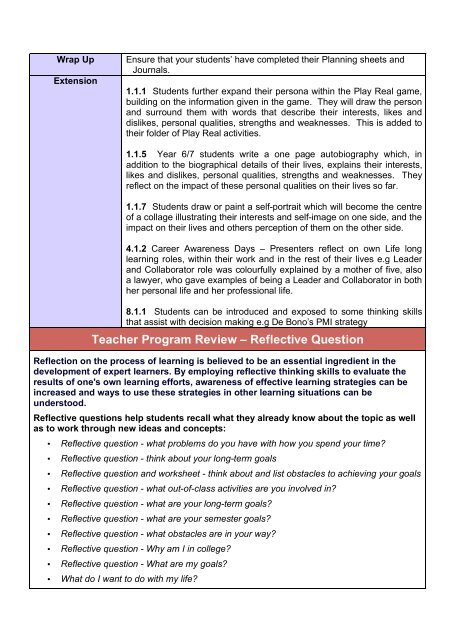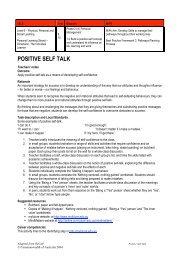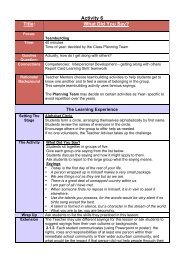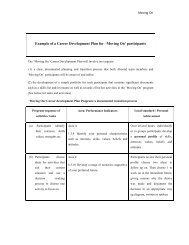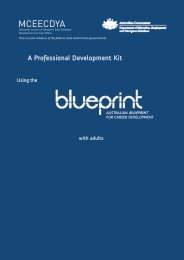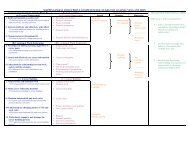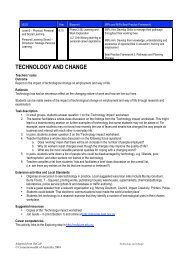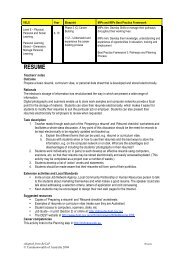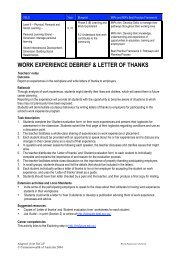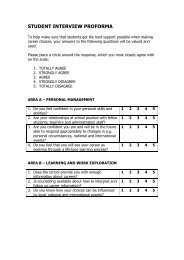Set_Goals_Plan_ Action - Blueprint - Australian Blueprint for Career ...
Set_Goals_Plan_ Action - Blueprint - Australian Blueprint for Career ...
Set_Goals_Plan_ Action - Blueprint - Australian Blueprint for Career ...
You also want an ePaper? Increase the reach of your titles
YUMPU automatically turns print PDFs into web optimized ePapers that Google loves.
Teaching PracticeThe Teacher’s Role in Adapting TextbooksKirkpatrick (2011) observed, however, that progress in developing regional varieties of English isbeing impeded by standardized textbooks and other materials currently in use, specificallyAmerican and British texts that largely present native-speaker norms. This is certainly asituation unlikely to change anytime soon, as Tomlinson (2006, p. 131) remarked:. . . all the coursebooks I know which are sold on the global market still use oneof these prestige standards as their model of correctness. It would be a bravepublisher who risked financial failure by publishing a global coursebook with anEIL core or a variety of world Englishes as its model(s).Fortunately, teachers in Cambodia and throughout the ASEAN region need not wait <strong>for</strong> eitherdaring publishers or innovative government policies to start moving toward an ELF multilingualmodel of teaching. Teachers themselves can start by making small adaptations in existing,widely used textbooks. The current reality is, however, that many instructors are hesitant tomake any changes in the textbook, even if their school directors allow it. This hesitancy,Richards suggested, is often based on the following assumptions about textbooks (1998, citedby McGrath, 2002):• Everything in a lesson is equally important <strong>for</strong> students.• Explanations and cultural in<strong>for</strong>mation in textbooks should not be questioned.• Teachers do not have the authority or expertise to adapt textbook lessons.• Activities in a textbook are always superior to those created by teachers.In addition to these beliefs, another factor might limit teachers’ willingness to modify textactivities: lack of experience. However, despite these factors, some Cambodian teachers havecome to recognize that textbook adaptation is not only important, but also achievable, even <strong>for</strong>teachers who have limited classroom experience. As shown below, all teachers can learn tologically, systematically, and simply make changes to their textbook material that willcontribute greatly toward student success in local and international contexts.The WhyWhy and How to Adapt MaterialsOnce teachers have accepted the idea that they can make changes to the text, the decision tochange has to be made based on the content of each activity. While the objective of an activitymay be important <strong>for</strong> students, its presentation might be too simple or uninteresting <strong>for</strong> them.Of course, care is required be<strong>for</strong>e making major changes to textbooks, since doing so couldundermine the student-teacher relationship--students might, <strong>for</strong> example, question the teachers’judgment or resent paying <strong>for</strong> a textbook that is not fully used. Thus, deciding wisely whetherto use an activity (and if so, to use it as is or to modify it) or not to use it (and then whether tosimply omit the activity or replace it with another) (Harmer, 2007) is the key to good textbookadaptation. Furthermore, if a decision has been made to adapt an activity to better meet theneeds of a particular classroom, the teacher must have and be able to articulate a clear ideawhy the material in the text needs to be made better. Among the reasons McGrath (2002) offersteachers to consider when they are contemplating adaptation of material are the following:Chea, Klein, and Middlecamp - Page 220


